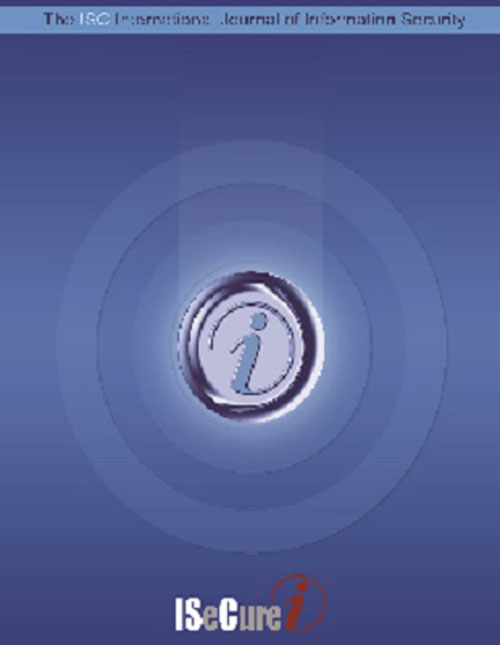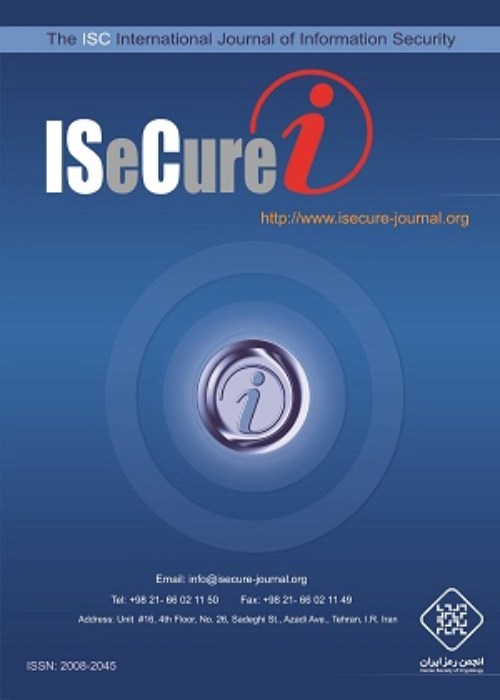فهرست مطالب

International Journal of Information Security
Volume:10 Issue: 1, Jan 2018
- تاریخ انتشار: 1397/01/07
- تعداد عناوین: 7
-
-
Pages 1-2
-
Pages 3-13Impossible differential attack is a well-known mean to examine robustness of block ciphers. Using impossible differential cryptanalysis, we analyze security of a family of lightweight block ciphers, named Midori, that are designed considering low energy consumption. Midori state size can be either 64 bits for Midori64 or 128 bits for Midori128; however, both versions have key size equal to 128 bits. In this paper, we mainly study security of Midori64. To this end, we use various techniques such as early-abort, memory reallocation, miss-in-the-middle and turning to account the inadequate key schedule algorithm of Midori64. We first show two new 7-round impossible differential characteristics which are, to the best of our knowledge, the longest impossible differential characteristics found for Midori64. Based on the new characteristics, we mount three impossible differential attacks on 10, 11, and 12 rounds on Midori64 with 287.7, 290.63, and 290.51 time complexity, respectively, to retrieve the master-key.Keywords: Midori, block cipher, impossible differential attack, cryptanalysis
-
Pages 15-27Due to the explosion of smart devices, data traffic over cellular networks has seen an exponential rise in recent years. This increase in mobile data traffic has caused an immediate need for offloading traffic from operators. Device-to-Device(D2D) communication is a promising solution to boost the capacity of cellular networks and alleviate the heavy burden on backhaul links. However, direct wireless connections between devices in D2D communication are vulnerable to certain security threats. In this paper, we propose an incentive-aware lightweight secure data sharing scheme for D2D communication. We have considered the major security challenges of the data sharing scheme, including data confidentiality, integrity, detecting message modification, and preventing the propagation of malformed data. We have also applied an incentive mechanism to motivate users involvement in the process of data sharing. Actually, D2D communication is highly dependent on user participation in sharing content, so, we apply the concept of virtual check to motivate users(named proxy users)to help the requesting user(client) in the process of obtaining the data. Unlike the previous studies, our proposed protocol is an stateless protocol and does not depend on the users contextual information. Therefore, it can be used at anytime and from anywhere. The security analysis proves that the proposed protocol resists the security attacks and meets the security requirements. The performance evaluation shows that the proposed protocol outperforms the previous works in terms of communication and computation cost. Thus, the proposed protocol is indeed an efficient and practical solution for secure data sharing in D2D communication.Keywords: D2D communications, traffic offloading, security, lightweight, data sharing, incentive
-
Pages 29-43Traffic classification plays an important role in many aspects of network management such as identifying type of the transferred data, detection of malware applications, applying policies to restrict network accesses and so on. Basic methods in this field were using some obvious traffic features like port number and protocol type to classify the traffic type. However, recent changes in applications make these features imperfect for such tasks. As a remedy, network traffic classification using machine learning techniques is now evolving. In this article, a new semi-supervised learning is proposed which utilizes clustering algorithms and label propagation techniques. The clustering part is based on graph theory and minimum spanning tree (MST) algorithm. In the next level, some pivot data instances are selected for the expert to vote for their classes, and the identified class labels will be used for similar data instances with no labels. In the last part, the decision tree algorithm is used to construct the classification model. The results show that the proposed method has a precise and accurate performance in classification of encrypted traffic for the network applications. It also provides desirable results for plain un-encrypted traffic classification, especially for unbalanced streams of data.Keywords: Traffic classification, Encrypted traffic, Network management, Traffic analysis
-
Pages 45-53In this paper we present a new finite field-based public key cryptosystem (NETRU) which is a non-commutative variant of CTRU. The original CTRU is defined by the ring of polynomials in one variable over a finite field F2. This system works in the ring R = F2[x]/hxN −1i and is already broken by some attacks such as linear algebra attack. We extend this system over finite fields Zp, where p is a prime (or prime power) and it operates over the non-commutative ring M = Mk(Zp)[T,x]/hXn − Ik∗ki, where M is a matrix ring of k by k matrices of polynomials in R = Zp[T,x]/hxn−1i. In the proposed NETRU, the encryption and decryption computations are non-commutative and hence the system is secure against linear algebra attack as lattice-based attacks. NETRU is designed based on the CTRU core and exhibits high levels of security with two-sided matrix multiplication.Keywords: Lattice-based Cryptography, CTRU, Matrix Rings, Finite Fields
-
Pages 55-61Nowadays, botnets are considered as essential tools for planning serious cyber attacks. Botnets are used to perform various malicious activities such as DDoS attacks and sending spam emails. Different approaches are presented to detect botnets; however most of them may be ineffective when there are only a few infected hosts in monitored network, as they rely on similarity in bots activities to detect the botnet. In this paper, we present a host-based method that can detect individual bot-infected hosts. This approach is based on botnet life-cycle, which includes common symptoms of almost all types of botnet despite their differences. We analyze network activities of each process running on the host and propose some heuristics to distinguish behavioral patterns of bot process from legitimate ones based on statistical features of packet sequences and evaluating an overall security risk for it. To show the effectiveness of the approach, a tool named BotRevealer has been implemented and evaluated using real botnets and several popular applications. The results show that in spite of diversity of botnets, BotRevealer can effectively detect the bot process among other active processes.Keywords: Botnet Detection, Botnet Life-Cycle, Host-Based Intrusion Detection, Heuristic Algorithm
-
Pages 63-69We propose a new online sortition protocol which is decentralized. We argue that our protocol has safety, fairness, randomness, non-reputation and openness properties.
Sortition is a process that makes random decision and it is used in competitions and lotteries to determine who is the winner. In the real world, sortition is simply done using a lottery machine and all the participant can be sure about the safety, fairness, randomness, non-reputation, and openness properties. But how we can do the sortition in virtual world such that it satisfies the desired properties? The idea is decentralization.
Using cryptography notions, we provide a protocol where all agents participate in computing the winner of sortition.
Our proposed protocol is new and completely differ with other sortition protocols and also it is decentralized. It is simple and easily can be implemented and find commercial use for those markets who wants to give present to their customers in a fair and clear manner.Keywords: Cryptography, Security Protocols, sortition, Lottery


